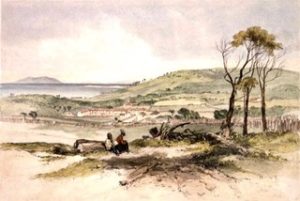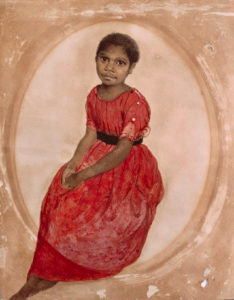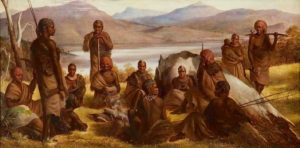AUTHOR’S NOTE ABOUT MATHINNA
The genesis of The Exiles was the story of British convict women exiled to Australia in the early-to-mid 19th century. But the more I learned about this time period, the more I saw that it would be irresponsible not to address the contemporaneous history of the Tasmanian Aboriginal people exiled from their own land by the British. In the course of my research I learned about a girl named Mathinna, the orphaned daughter of a chieftain who was taken on a whim and later abandoned by the British governor and his wife. Mathinna’s tragic story is in many ways representative of what the British did to the Aboriginal people in Australia in the 19th century. First objectified, then ignored, and finally cast aside, Mathinna was never accorded the dignity or respect of full personhood.

Each character in The Exiles has a storyline that ends on a precipice — some literal, some figurative. The story from Mathinna’s perspective ends when she is about to be exiled from the governor’s house and sent to an orphanage. When we see her again through the eyes of another character, several years later, it is clear that her life has been, and will continue to be, unrelentingly hard.
It’s complicated to write about real people whose lives ended long ago, their fates solidified. I knew from the beginning that I did not want to depict the brutal final years of Mathinna’s life. Her story, in my novel, is sad enough. After being abandoned, the real-life Mathinna was sent to an orphanage and then an open-air prison before being shunted off to a grim former convict station. She was abused, starved, and mistreated. According to various reports, she was never able to settle into any community. She descended into destitution and probably alcoholism before drowning in mysterious circumstances at the age of 17. It was never determined whether her death was murder, suicide, or a drunken mistake.
As I did in my previous novel, A Piece of the World, I chose to end Mathinna’s story with a moment of connection, of recognition. Like Mathinna’s, the final years of Christina Olson, the real-life person who inspired that novel, were bleak. I wanted to end the stories from Mathinna’s and Christina’s perspectives by highlighting their resilience – to show that even in the midst of suffering, there can be moments of grace.

I encourage readers to learn more about Mathinna’s story. I found the following resources especially valuable: The Last of the Tasmanians: Or, The Black War of Van Diemen’s Land (1870), by James Bonwick; The Ambitions of Jane Franklin, by Alison Alexander; Wanting, a novel by Richard Flanagan; Tunnerminnerwait and Maulboyheenner: The Involvement of Aboriginal People from Tasmania in Key Events of Early Melbourne, by Clare Land; “Tasmanian Gothic: the art of Tasmania’s Forgotten War,” by Gregory Lehman; “Extermination, Extinction, Genocide: British Colonialism and Tasmanian Aborigines,” by Shayne Breen; “In Black and White,” by Jared Diamond; and “From Terror to Genocide: Britain’s Tasmanian Penal Colony and Australia’s History Wars,” by Benjamin Madley. I was also inspired by excerpts from the Bangarra Dance Theatre’s performance of “Mathinna,” choreographed by Stephen Page and available on YouTube and the Bangarra Dance Theatre website (https://www.bangarra.com.au). Scroll down to watch them.
Other useful online resources include the Wikipedia page for Mathinna; Alison Alexander’s article “Mathinna” at the National Centre of Biography at the Australian National University; “Mathinna” at the Centre for Tasmanian Historical Studies; the Mathinna Study Guide/Bangarra; the webpsite on the Uluru movement for representation; and “The hidden story of Mathinna: spirited, gifted, utterly destroyed,” by Carol Raabus at ABC Radio Hobart.
I am grateful to Dr. Gregory Lehman, Pro Vice-Chancellor of Aboriginal Leadership at the University of Tasmania and a descendant of the Trawulwuy people of northeast Tasmania, for critiquing the sections about Mathinna and the history of the Tasmanian Aboriginal people.

Below are two excerpts from Mathinna, by Stephen Page, performed by the Bangarra Dance Theatre, whose performers all have Aboriginal and/or Torres Strait Islander backgrounds. This dance premiered at the Arts Centre Melbourne in 2008 and has been been performed widely all over Australia. I found it moving and inspiring as I wrote Mathinna’s story in THE EXILES. As Bangarra’s website explains, “Inspired by a young girl’s journey between two cultures, Mathinna traces the story of a young Aboriginal girl removed from her traditional home and adopted into western colonial society, only to be ultimately returned to the fragments of her original heritage. Mathinna has become the archetype of the ‘stolen child’ and, in this outstanding work, Bangarra recreates her powerful story of vulnerability and searching in an era of confusion and intolerance.”
Two-and-a-half minute excerpt:
Seven-minute excerpt:

